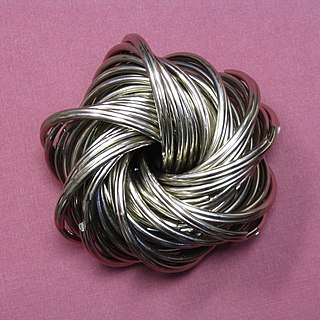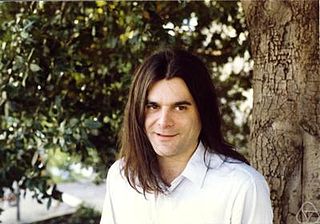In mathematics, equivariance is a form of symmetry for functions from one symmetric space to another. A function is said to be an equivariant map when its domain and codomain are acted on by the same symmetry group, and when the function commutes with the action of the group. That is, applying a symmetry transformation and then computing the function produces the same result as computing the function and then applying the transformation.
Daniel Gray "Dan" Quillen was an American mathematician.
In stable homotopy theory, a branch of mathematics, Morava K-theory is one of a collection of cohomology theories introduced in algebraic topology by Jack Morava in unpublished preprints in the early 1970s. For every prime number p, it consists of theories K(n) for each nonnegative integer n, each a ring spectrum in the sense of homotopy theory. Johnson & Wilson (1975) published the first account of the theories.

In the mathematical field of algebraic topology, the homotopy groups of spheres describe how spheres of various dimensions can wrap around each other. They are examples of topological invariants, which reflect, in algebraic terms, the structure of spheres viewed as topological spaces, forgetting about their precise geometry. Unlike homology groups, which are also topological invariants, the homotopy groups are surprisingly complex and difficult to compute.
In mathematics, and especially in homotopy theory, a crossed module consists of groups G and H, where G acts on H by automorphisms (which we will write on the left, , and a homomorphism of groups
In mathematics, stable homotopy theory is that part of homotopy theory concerned with all structure and phenomena that remain after sufficiently many applications of the suspension functor. A founding result was the Freudenthal suspension theorem, which states that for a given CW-complex X the (n+i)th homotopy group of its ith iterated suspension, πn+i (ΣiX), becomes stable for large but finite values of i. For instance,
In mathematics, equivariant cohomology is a cohomology theory from algebraic topology which applies to topological spaces with a group action. It can be viewed as a common generalization of group cohomology and an ordinary cohomology theory. Specifically, the equivariant cohomology ring of a space X with action of a topological group G is defined as the ordinary cohomology ring with coefficient ring of the homotopy quotient :

Graeme Bryce Segal FRS is an Australian mathematician, and professor at the University of Oxford.
In mathematics, topological modular forms (tmf) is the name of a spectrum that describes a generalized cohomology theory. In concrete terms, for any integer n there is a topological space tmfn, and these spaces are equipped with certain maps between them, so that for any topological space X, one obtains an abelian group structure on the set tmfn(X) of homotopy classes of continuous maps from X to tmfn. One feature that distinguishes tmf is the fact that its coefficient ring, tmf0(point), is almost the same as the graded ring of holomorphic modular forms with integral cusp expansions. Indeed, these two rings become isomorphic after inverting the primes 2 and 3, but this inversion erases a lot of torsion information in the coefficient ring.
In algebraic geometry and algebraic topology, branches of mathematics, A1homotopy theory is a way to apply the techniques of algebraic topology, specifically homotopy, to algebraic varieties and, more generally, to schemes. The theory is due to Fabien Morel and Vladimir Voevodsky. The underlying idea is that it should be possible to develop a purely algebraic approach to homotopy theory by replacing the unit interval [0, 1], which is not an algebraic variety, with the affine line A1, which is. The theory requires a substantial amount of technique to set up, but has spectacular applications such as Voevodsky's construction of the derived category of mixed motives and the proof of the Milnor and Bloch-Kato conjectures.
The Atiyah–Segal completion theorem is a theorem in mathematics about equivariant K-theory in homotopy theory. Let G be a compact Lie group and let X be a G-CW-complex. The theorem then states that the projection map

Michael Jerome Hopkins is an American mathematician known for work in algebraic topology.
In mathematics, assembly maps are an important concept in geometric topology. From the homotopy-theoretical viewpoint, an assembly map is a universal approximation of a homotopy invariant functor by a homology theory from the left. From the geometric viewpoint, assembly maps correspond to 'assemble' local data over a parameter space together to get global data.
In mathematics, a highly structured ring spectrum or -ring is an object in homotopy theory encoding a refinement of a multiplicative structure on a cohomology theory. A commutative version of an -ring is called an -ring. While originally motivated by questions of geometric topology and bundle theory, they are today most often used in stable homotopy theory.
In category theory and homotopy theory the Burnside category of a finite group G is a category whose objects are finite G-sets and whose morphisms are spans of G-equivariant maps. It is a categorification of the Burnside ring of G.
This is a glossary of properties and concepts in algebraic topology in mathematics.



